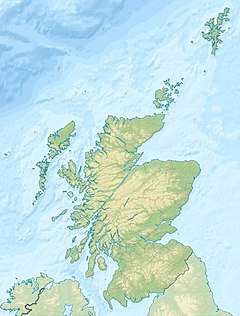Sula Sgeir
| Gaelic name | Sula Sgeir |
|---|---|
| Norse name | Súlasker |
| Meaning of name | Gannet Skerry |
| Location | |
|
Sula Sgeir shown within Scotland
|
|
| Coordinates | 59°05′N 6°09′W / 59.09°N 6.15°W |
| Physical geography | |
| Island group | North Atlantic |
| Area | 15 ha |
| Administration | |
| Sovereign state | United Kingdom |
| Country | Scotland |
| Council area | Comhairle nan Eilean Siar |
| Demographics | |
| Population | 0 |
| References | |

Lighthouse and Cairn on Sulasgeir
|
|
|
Scotland
|
|
| Location | Sula Sgeir |
|---|---|
| Coordinates | 59°05′36″N 6°09′34″W / 59.093455°N 6.159318°W |
| Foundation | concrete basement |
| Construction | metal tower |
| Tower shape | square parallelepiped with lantern |
| Markings / pattern | white tower |
| Height | 5 metres (16 ft) |
| Focal height | 74 metres (243 ft) |
| Light source | solar power |
| Range | 11 nautical miles (20 km; 13 mi) |
| Characteristic | Fl W 15s. |
| Admiralty number | A3870 |
| NGA number | 3572 |
| ARLHS number | SCO-230 |
| Managing agent | Rona and Sula Sgeir National Nature Reserve |
Sula Sgeir is a small, uninhabited Scottish island in the North Atlantic, 18 kilometres (11 miles) west of North Rona. One of the most remote islands of the British Isles, it lies more than forty miles (64 kilometres) north of Lewis and is best known for its population of gannets.
Although seemingly very inhospitable to humans, there is a ruined stone bothy called Taigh Beannaichte (Blessed House) on the east headland Sgeir an Teampaill. The hard gneiss rock of which the island is made splits into long pieces, which are excellent for building bothies and cairns, but the hard rough boulders and sharp rocks make for difficult walking.
The sea has burrowed right through the southern part of the island in a series of interconnected and spectacular caves which can be explored in calm weather by inflatable. The small lighthouse on the south end at Sròn na Lice is regularly damaged by the huge seas which break right over the rock during Atlantic storms.
Despite this there is a surprising amount of vegetation, and the thrift is especially colourful in June, which is probably the best month to visit.
The modern name is from the Old Norse súla, "gannet" and sker, "skerry". In the 16th century Dean Munro referred to the island as "Suilskeray". Macculloch's 1819 Description refers to "Sulisker", an Anglicised spelling that is still occasionally used. A skerry in Utsira, Norway has a name with the same origin, Suleskjer; there is also a Sule Skerry in Orkney.
St Ronan's sister, Brenhilda, is supposed to have stayed here for some time, leaving him on Rona, only to be found dead in a bothy with a shag’s nest in her ribcage.
...
Wikipedia


